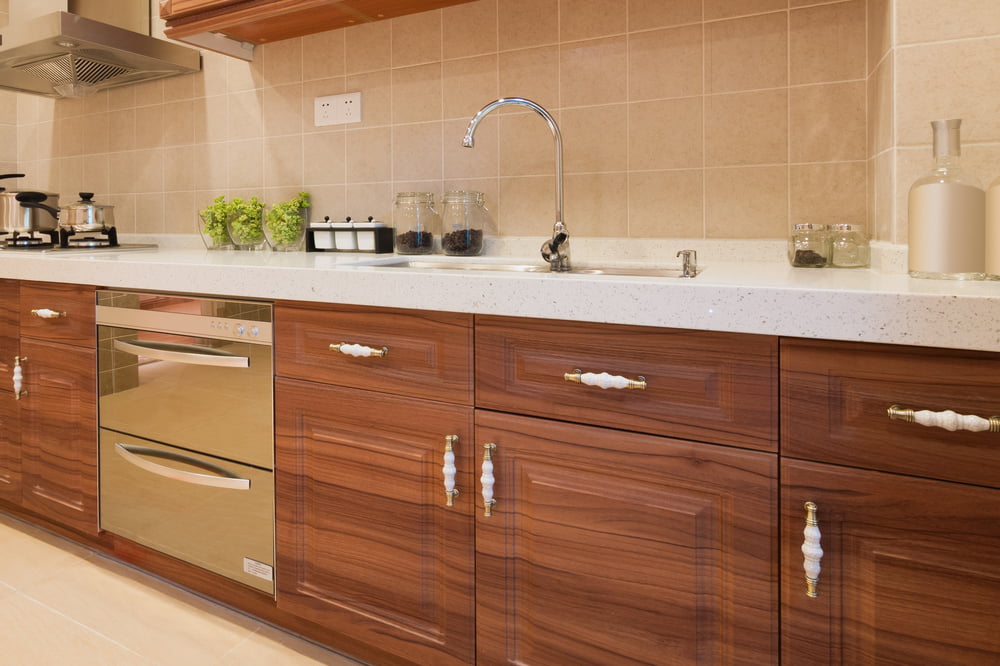5 common kitchen cabinet types

When it comes to designing your kitchen, the type of cabinets you choose can significantly impact the overall look, functionality, and organization of the space. With a wide range of options available, you can enhance both the esthetics and functionality of your kitchen. To make an informed decision for your ideal kitchen, explore popular cabinet types and seek the advice of professionals who can help you determine the best choice.
Shaker cabinets
Shaker cabinets are a timeless classic known for their simplicity and versatility. Inspired by the Shaker furniture design principles of minimalism and functionality, these cabinets feature clean lines and a five-piece door with a recessed center panel. Shaker cabinets can complement a wide range of kitchen styles, making them a popular choice for both traditional and modern designs.
One of the key advantages of Shaker cabinets is their durability. Typically crafted from solid wood, they can withstand the wear and tear of daily kitchen activities. Whether you choose painted Shaker cabinets for a clean, contemporary look or opt for stained wood cabinets to add warmth and richness, you can count on their enduring appeal.
Glass-front cabinets
Glass-front cabinets add a touch of elegance and sophistication to any kitchen. These cabinets feature glass panels on their doors, allowing you to showcase your finest china, glassware, or collectibles. They come in various styles, including mullion patterns, which are decorative elements that hold the glass panes.
One advantage of glass-front cabinets is their ability to make your kitchen more open and spacious. They can reflect light and create a sense of transparency, making even small kitchens appear larger. Depending on your preferences, you can choose clear glass for maximum visibility, frosted glass for a touch of privacy, or textured glass for added visual interest.
Frameless cabinets
Frameless cabinets, also known as European-style cabinets, offer a sleek and modern look. Unlike traditional cabinets with face frames, frameless cabinets have a full-overlay design, with cabinet doors covering the entire front frame. This creates a seamless, uninterrupted appearance that’s perfect for contemporary kitchens.
One of the primary benefits of frameless cabinets is their efficient use of space. Since there is no face frame, you get more room for storage. These cabinets often feature full-extension drawers and pull-out trays, which make it easy to access your kitchen essentials. To further enhance organization, you can customize the interior with various accessories, such as pull-out spice racks, utensil dividers, and tray organizers.
Beadboard cabinets
Beadboard cabinets exude rustic charm and country-style warmth. They are known for their characteristic vertical panels, or “beads,” that run along the cabinet doors and drawer fronts. Beadboard cabinets can be painted or stained in various colors to suit your kitchen’s style. One of the key advantages of beadboard cabinets is that they add visual interest and texture to your kitchen. The beadboard detailing creates a cozy and inviting atmosphere.
Whether aiming for a cottage-inspired look or infusing some rustic character into your kitchen, beadboard cabinets can achieve that effect beautifully.
Inset cabinets
Inset cabinets are the epitome of precision and craftsmanship. These cabinets feature doors and drawers that are set into the cabinet frame, resulting in a seamless appearance. The precise fit not only enhances the cabinet’s visual appeal but also ensures a consistent, tight fit that prevents door or drawer misalignment over time.
One notable advantage of inset cabinets is their high-end, custom look. They are often associated with luxury kitchen designs due to their attention to detail. Inset cabinets typically have concealed, soft-close hinges, ensuring a gentle and quiet closing motion. This feature adds to the overall functionality and convenience of the cabinets.
Selecting the perfect kitchen cabinets involves more than choosing a style that catches your eye. To ensure that your cabinets meet your expectations and needs, you should take several important factors into account. Here are some key considerations to keep in mind when selecting kitchen cabinets:
Kitchen layout and space
Before browsing cabinet styles, evaluate your kitchen’s layout and available space. Consider factors such as the kitchen’s size, the location of windows and doors, and any architectural features that may affect cabinet placement. Take precise measurements to determine the dimensions of your available space. This will help you choose cabinets that fit perfectly and maximize your kitchen’s efficiency.
Cabinet style
The style of your kitchen cabinets should harmonize with the overall design of your home. Whether you prefer classic, contemporary, or something in between, select cabinet styles and finishes that align with your vision. Remember that cabinet styles can significantly impact the atmosphere of your kitchen. For example, Shaker cabinets offer a timeless look, while frameless cabinets create a modern esthetic.
Budget
Establishing a budget for your kitchen cabinet project is essential. Cabinets can vary significantly in price, so it’s important to determine how much you’re willing to invest. Cabinets are a long-term investment in your home, so prioritize quality and durability. While it’s tempting to cut costs, investing in well-made cabinets will pay off in the long run.
Storage needs
Assess your storage needs and preferences. Consider the types of items you’ll be storing in your kitchen and choose cabinets that efficiently accommodate those items. Options like pull-out shelves, lazy Susans, and deep drawers can optimize storage space and make it easier to access your kitchen essentials.
Finish and color
The finish and color of your cabinets are crucial for achieving your desired kitchen ambiance. Light-colored cabinets make a small kitchen feel more spacious, while dark cabinets add warmth and depth. Consider factors such as maintenance.
Installation
Proper cabinet installation is essential for the longevity and functionality of your kitchen. Ensure that you work with experienced professionals or follow manufacturer instructions if you’re installing cabinets yourself. Accurate installation ensures your cabinets are level, plumb, and securely attached.









